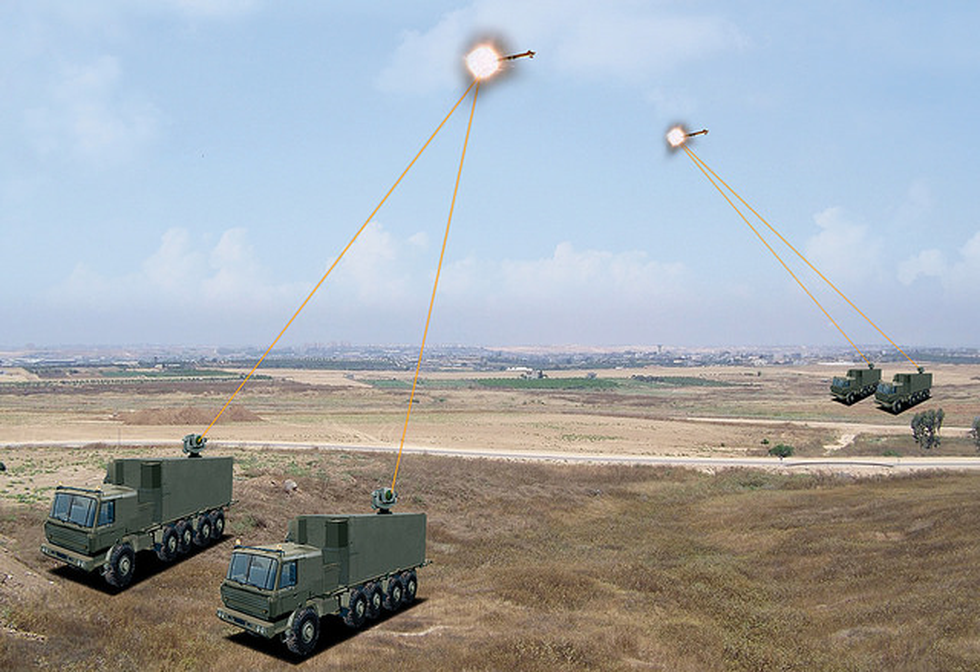
About Iron Beam:
- The Iron Beam, also known as Magen or Light Shield, is a new laser-based missile defence system developed by Israel.
- It is a 100kW class High Energy Laser Weapon System (HELWS) that is expected to become the first operational system in its class.
- It is a directed-energy weapon air defence system that fires powerful beams of light that can destroy fast-moving projectiles.
- Built by Rafael Advanced Defense Systems, Iron Beam was first unveiled in 2014.
- Its operational range extends up to 7 km (4.3 miles).
Advantages:
- With a continuous energy supply for the laser, the advantage lies in never depleting ammunition, ensuring a sustained capability for defense.
- The absence of conventional ammunition will directly result in significant cost savings.
- Complementing Israel’s Irom Dome, it can be integrated with a range of platforms and can become part of any multilayer defence system.
Disadvantages:
- Diminished effectiveness during restricted visibility, such as heavy cloud cover or adverse weather conditions.
- It cannot operate effectively in wet conditions—the more moisture in the atmosphere, the more water particles absorb the laser’s energy.
- Iron Beam requires a direct line of sight between the system and its target, making its placement far more critical.
- It also has a much slower rate of fire, requiring five seconds or so to transmit sufficient energy to destroy its target.
2. Alstonia scholaris
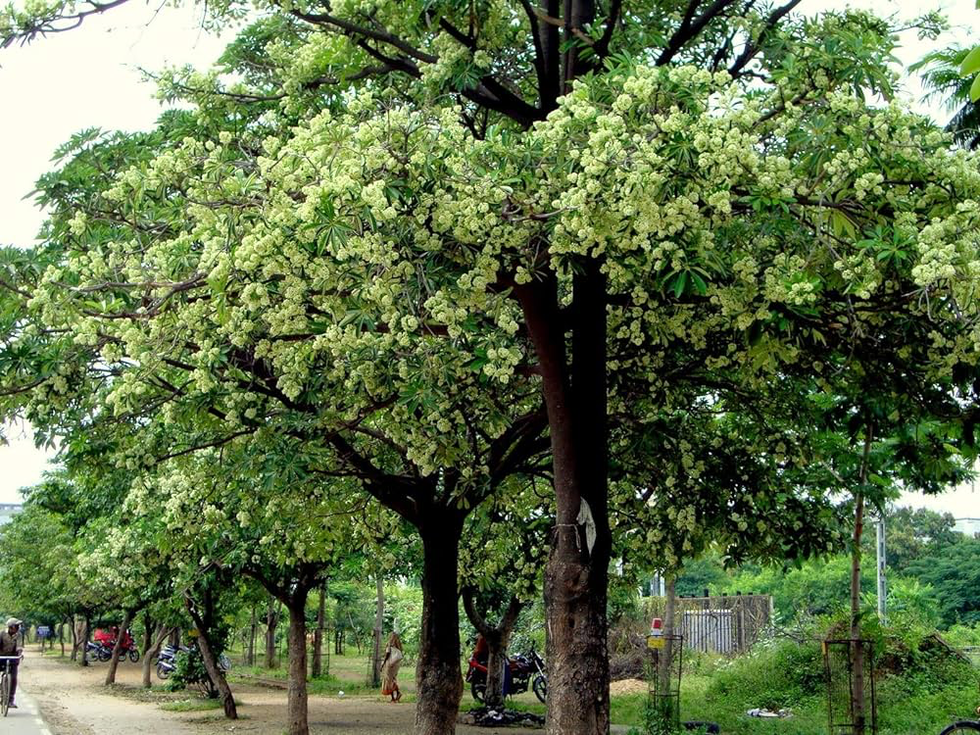
About Alstonia scholaris:
- Alstonia scholaris, commonly called blackboard tree, scholar tree, milkwood, or devil's tree in English, is an evergreen tropical tree in the dogbane family (Apocynaceae).
- It is called 'Saptaparna' in India. It has been cited in the Charaka and Sushrutha Samhithas.
- Distribution: This tree is widespread across the Indian subcontinent, Southeast Asia, and southern China, thriving in tropical and subtropical climates.
Features:
- It grows to a height of 10–20 meters, sometimes reaching up to 40 meters.
- It has dark grey bark and a crown of simple, whorled leaves arranged in clusters of seven, giving rise to the name "saptaparni" (meaning "seven leaves").
- Flowers: Small, fragrant, and greenish-white flowers bloom in clusters during late autumn and early winter.
Uses:
- The bark, leaves, and other parts of Alstonia scholaris have been used in traditional medicine for treating respiratory conditions, fever, skin disorders, and digestive issues.
- The soft, lightweight wood of the blackboard tree was historically used for making writing slates and blackboards, which is how it got the common name "blackboard tree."
- IUCN status: Least Concern
3. Transponder

About Transponder:
- A transponder is a wireless communication, monitoring, or control device that picks up and automatically responds to an incoming signal.
- The term is a combination of transmitter and responder.
- Transponders are typically used for detecting, identifying, and locating objects, but they can also be used in other technologies, such as satellites to relay communications signals.
- Transponders are commonly found in both civilian and military aircraft and in objects, such as car keys.
How do transponders work?
- Transponders operate using radio frequencies and respond to wireless monitoring, communications, and control device signals.
- When sent a signal-also called an interrogator-a transponder responds by returning an identifying signal.
- The information included in the response varies depending on the type of transponder but can include location and identifying codes.
- The transponder automatically sends back a radio signal at a predetermined frequency.
- To receive and send signals simultaneously, receiving and transmitting signals must be set at different frequencies.
- For Example: An air traffic controller can send an interrogator signal and receive identifying information on an aircraft. This enables the control tower to track the aircraft in the surrounding airspace and provide other information to help the pilots maintain adequate distance from other aircraft.
Transponders are used with the following technologies:
- aircraft identification;
- communications satellites;
- vehicle keys;
- optical communications;
- sonar;
- electronic toll collection systems;
- lap timing and tyre identification for motorsports; and
- magnetic labels on credit cards.
4. Global Tuberculosis (TB) Report 2024
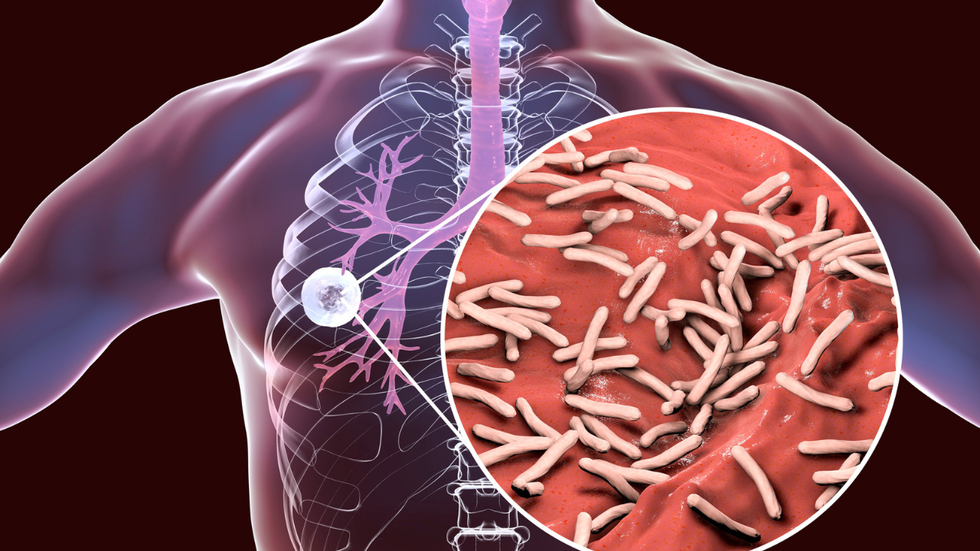
About Global TB Report:
- It is an annual report published by the World Health Organization (WHO).
- It provides a comprehensive and up-to-date assessment of the TB epidemic and of progress in prevention, diagnosis, and treatment of the disease at global, regional, and country levels.
Highlights of the 2024 Report:
- It shows 8.2 million people were newly diagnosed with TB in 2023, a figure that represents the highest number of TB cases recorded by the WHO since it began global TB monitoring in 1995.
- It also marks a significant increase from the 7.5 million new TB cases reported in 2022.
- Although the estimated number of 1.25 million TB deaths in 2023 is down from the 1.32 million recorded in 2022 and continues a declining trend from the height of the COVID-19 pandemic, that number still far surpasses the 320,000 COVID deaths officially reported to the WHO last year.
- The data show that 30 mostly low- and middle-income countries (LMICs) bear 87% of the global TB burden, with five countries—India (26%), Indonesia (10%), China (6.8%), the Philippines (6.8%), and Pakistan (6.3%)—combining for 56% of the burden.
- 55 percent of people who developed TB were men, 33 percent were women, and 12 percent were children and young adolescents.
- According to the report, a significant number of new TB cases are driven by five major risk factors: undernutrition, HIV infection, alcohol use disorders, smoking, and diabetes.
- In 2023, India was estimated to have had 27 lakh TB cases, of which 25.1 lakh persons were diagnosed and put on treatment.
- This has buoyed India's treatment coverage to 89 percent in 2023 from 72 percent in 2015, thereby bridging the gap of missing cases.
- It acknowledged a drop in India's TB incidence - from 237 per lakh population in 2015, to 195 per lakh population in 2023, accounting for a 17.7 percent decline.
5. Turtle Wildlife Sanctuary

About Turtle Wildlife Sanctuary:
- Turtle (Kachhua) Wildlife Sanctuary is located in the Varanasi District of Uttar Pradesh.
- It was touted as the first freshwater turtle wildlife sanctuary in the country.
- The protected area is a 7 km stretch of the Ganga River flowing through Varanasi city from Ramnagar Fort to Malviya Rail/Road Bridge.
- The sanctuary was declared to ensure the survival of turtles released into the Ganga River in Varanasi.
- The turtles were released to promote the organic removal of half-burnt human corpses, which are dumped into the river after final rites under Hindu tradition.
- To get rid of these without hurting the sentiments of the people, the Ganga Action Plan supported the breeding and release of turtles into the river.
- The idea behind the action was that this would in turn nurture a good population of the already dwindling population of Indian softshell turtles.
- Turtle hatchlings are reared at the breeding center in Sarnath and subsequently released into the Ganges River once they become mature enough to survive in their natural habitat.
- According to local officials, about 2,000 turtle eggs are brought to the centre from the Chambal and Yamuna rivers every year.
- The sanctuary is also home to the Gangetic Dolphin, other species of turtles, and several species of fish, including Rohu, Tengra, and Bhakur.
6. Key facts about Papua New Guinea
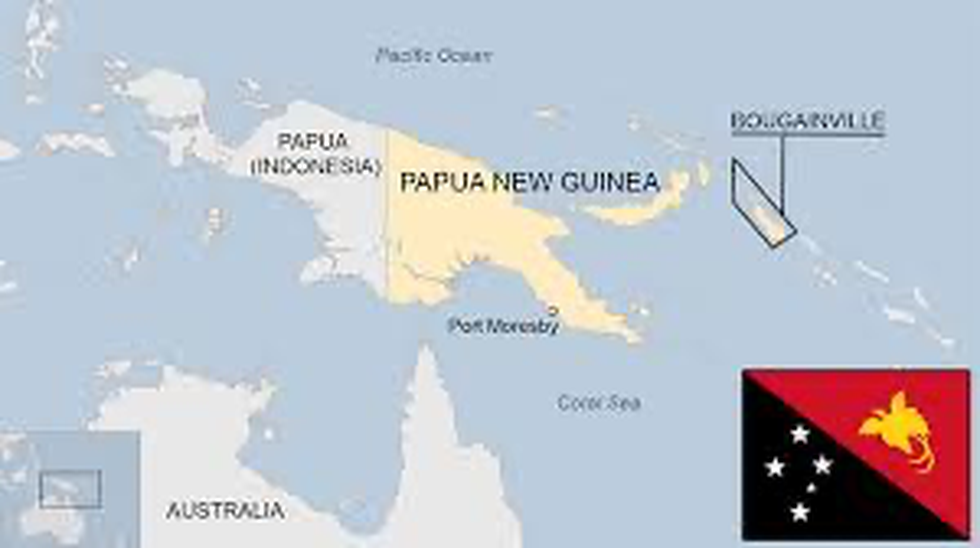
About Papua New Guinea:
- It is an island country that lies in the south-western Pacific.
- It includes the eastern half of New Guinea (the world’s second-largest island) and many small offshore islands.
- Neighbors: Indonesia to the west, Australia to the south, and the Solomon Islands to the southeast.
- Terrain: It is mainly mountainous but has low-lying plains in southern New Guinea.
- The islands that constitute Papua New Guinea were settled over a period of 40,000 years by a mixture of peoples who are generally referred to as Melanesians.
- Language: English is the main language of government and commerce. In most everyday contexts, the most widely spoken language is Tok Pisin.
- Government: The country is a constitutional monarchy and a member of the Commonwealth.
- The British monarch, represented by a governor-general, is the head of state, and the Prime Minister is the head of government.
- Papua New Guinea’s rainforests are rich in biodiversity, housing rare species such as birds of paradise, tree kangaroos, and the Queen Alexandra’s birdwing butterfly.
- These forests represent only one per cent of Earth’s land but play a vital role in absorbing carbon and supporting the lives and traditions of Papua New Guinea’s indigenous peoples.
- Capital: Port Moresby
7. Markhor
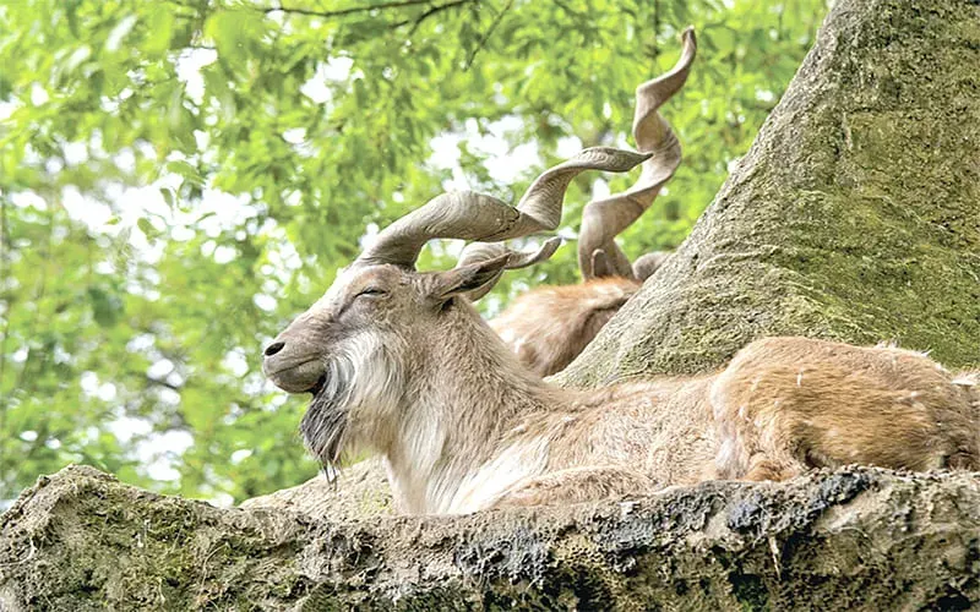
About Markhor:
- The markhor is a wild goat species indigenous to the mountainous regions of Central and South Asia.
- It is known for its thick fur, flowing beard and corkscrew horns.
- It is considered to be an apt flagship species for catalysing conservation in these mountain tracks.
- It is adapted to mountainous terrain, between 600 and 3,600 m elevation, with open woodlands, scrublands and light forests.
- It is a diurnal animal and is mainly active in the early morning and late afternoon.
Geographical distribution:
- It is found in the moist to semi-arid mountain tracts of Pakistan, India, Afghanistan, Uzbekistan, Turkmenistan and Tajikistan.
- In J&K, Markhor’s population is found in Shopian, Banihal passes to the Shamsbari area of the Kazinag Uri and Pir Panjal range in Poonch.
Conservation status
- IUCN: ‘Near Threatened’
- Wildlife (Protection) Act, 1972: Schedule I
- CITES: Appendix I
- Threats: Its population has been affected mostly by unabated human intervention and biotic factors.
8. Black hole Triple System

About Black Hole Triple System:
- The system comprises a black hole at its centre, currently in the process of consuming a small star spiralling very close to it.
- There is also a second star, which appears to be circling the black hole but is actually far away.
- The discovery of the system, located about 8,000 light years away from Earth has raised questions about how black holes are formed.
- Many black holes discovered until now have been part of binary systems, consisting of a black hole and a secondary object (such as a star or another black hole).
- But the black hole triple not only has one star which orbits the black hole about every 6.5 days, but also a more far-off star which orbits it every 70,000 years.
- It is situated in the constellation of Cygnus, the system features one of the oldest known black holes, the V404 Cygni, which is nine times as big as the Sun in our solar system.
- V404 Cygni has two stars around it as the black hole did not arise from a supernova, which typically kicks away outer stars in the explosion.
- Instead, it was formed through another process called “direct collapse”, where the star caves in after expending all its fuel, but does not explode.
9. Indian Green Building Council

About Indian Green Building Council:
- It is part of the Confederation of Indian Industry (CII) which was formed in the year 2001.
- It is India's Premier certification body.
- The council offers a wide array of services which include developing new green building rating programmes, certification services and green building training programmes.
- The council also organises the Green Building Congress, its annual flagship event on green buildings.
- It is also among the 5 countries that are on the board of the World Green Building Council discussing global issues at COP and similar global platforms.
- The rating is based on six environmental categories which include sustainable station facility, health, hygiene and sanitation, energy efficiency, water efficiency, smart and green initiatives and innovation and development.
- Headquarter: Hyderabad.
Key facts about Durgesh Aranya Zoological Park
- It is located in the Bankhandi area of Kangra’s Dehra assembly constituency of Himachal Pradesh.
- The Central Zoo Authority (CZA) has approved 34 enclosures within the park’s Van Vaibhav Path and Biodiversity Court, which will house 73 animal species, including the Asiatic lion, hog deer, crocodile, monitor lizard, gharial, and various birds.
- The project aligns with the state government’s focus on promoting eco-tourism and sustainable development, reinforcing Kangra’s status as the “Tourism Capital” of Himachal Pradesh.
10. Hydrogels
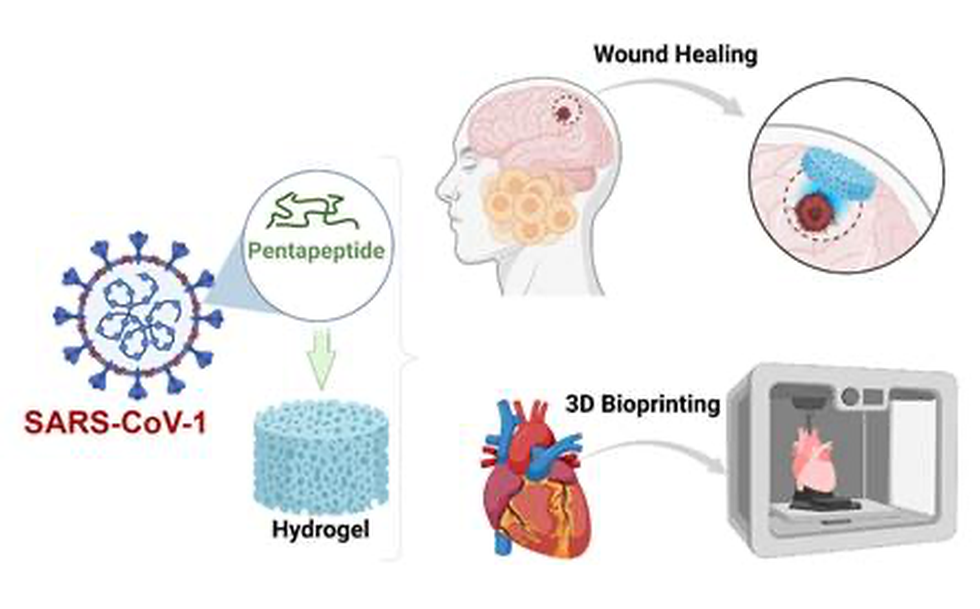
About Hydrogels:
- It is a three-dimensional network composed of hydrophobic polymers synthesized by crosslinking water-soluble polymers.
- Hydrogels can retain a large quantity of water within their network without disturbing their original structure. This imparts flexibility and swelling properties to the hydrogel structures.
- It is a “smart” material that can change its structure in response to its environment, such as the local temperature, pH, salt or water concentration.
What is SARS?
- Severe Acute Respiratory Syndrome (SARS) is a viral respiratory disease caused by the virus SARS-CoV-1.
- It is an airborne virus and can spread through small droplets of saliva in a similar way to the cold and influenza.
- It can also be spread indirectly via surfaces that have been touched by someone who is infected with the virus.
- Symptoms of SARS include: Persistent, high fever, Chills, Headache and Body aches.
- Treatment: There’s no established treatment specifically for SARS.


























































































































































.png)
.png)
.png)
.png)
.png)


.png)
.png)
.png)





.png)
.png)






.png)
.png)
.png)
.png)
.png)
.png)
.png)
.png)
.png)

.png)







.png)
.png)


.png)
.png)
.png)


.png)

.png)
.png)





.jpg)

.png)
.png)


.png)

.png)
.png)
.png)

.jpg)

.jpg)


.png)

.png)
.png)
.png)
.png)
.png)
.png)
.png)
.png)
.png)
.png)




.png)

.png)





.png)
.png)
.png)
.png)
.png)
.png)
.png)
.png)
.png)
.png)
.jpg)
.jpg)

.png)
.png)
.png)
.png)
.png)
.png)
.png)
.png)
.png)
.png)
.png)
.png)
.png)
.png)
.png)
.png)
.png)
.png)
.png)
.png)
.png)
.png)



.png)
.png)

.jpg)
.jpg)


.jpg)
.jpg)
.jpg)
.jpg)
.jpg)

.jpg)








.jpg)
.jpg)
.jpg)
.jpg)
.jpg)

















.jpg)
.jpg)







.jpg)


















.jpg)
.jpg)






























































































.jpg)
.jpg)


























.jpg)

.jpg)










.jpg)








.jpg)




.jpg)










.jpg)


















.jpg)












































.jpg)














.jpg)
.jpg)
.jpg)





.jpg)

.jpg)
.jpg)





































































.jpg)


































.jpg)
.jpg)
















































.jpg)












.jpg)


.jpg)




.jpg)
.jpg)
.jpg)

.jpg)
.jpg)
.jpg)
.jpg)

.jpg)
.jpg)
.jpg)

.jpg)
.jpg)
.jpg)
.jpg)
.jpg)
.jpg)
.jpg)
.jpg)

.jpg)


.jpg)
.jpg)
.jpg)
.jpg)
.jpg)
.jpg)
.jpg)
.jpg)
.jpg)
.jpg)











.jpg)
.jpg)





.jpg)
.jpg)
.jpg)
























.jpg)
























.jpg)









.jpg)
.jpg)







.jpg)
.jpg)









































.jpg)
.jpg)
.jpg)
.jpg)
.jpg)

.jpg)
.jpg)
.jpg)
.jpg)
.jpg)


.jpg)
.jpg)
.jpg)
.jpg)
.jpg)

.jpg)
.jpg)
.jpg)
.jpg)
.jpg)
.jpg)
.jpg)
.jpg)
.jpg)
.jpg)
.png)

.png)
.png)

.png)
.png)
.png)
.png)


.jpg)
.jpg)

.jpg)
.jpg)
.jpg)

.png)
.png)
.png)
.png)
.png)
.png)
.png)

.png)
.png)
.png)
.png)
.png)
.png)
.png)
.png)
.png)
.png)





































































-min.png)



.png)




.png)








































